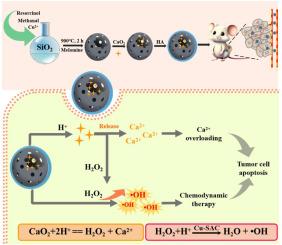A TME-responsive nanocatalytic platform for synergistically enhanced chemodynamic therapy through calcium overload for precision cancer treatment
IF 11.6
2区 材料科学
Q1 CHEMISTRY, PHYSICAL
引用次数: 0
Abstract
In this study, we successfully developed an atomically dispersed mesoporous hollow copper single-atom catalyst (Cu-SAC). This innovative catalyst was further enhanced by the synchronous loading of calcium peroxide (CaO2) and surface coating with hyaluronic acid (HA), which were designed to elevate the intratumoral concentration of hydrogen peroxide (H2O2) and introduce calcium ions (Ca2+). Under the acidic tumor microenvironment (TME), CaO2 responded by releasing Ca2+ and generating H2O2 in situ. Simultaneously, Cu-SAC exhibited Fenton-like reaction activity in the presence of H2O2, efficiently catalyzing the generation of hydroxyl radicals (‧OH). The generated ‧OH induced the cellular oxidative damage and led to depolarization of the mitochondrial membrane potential. Subsequently, the released Ca2+ was induced into the mitochondria, inducing Ca2+ overload. The synergistic effect of Cu-SAC mediated chemodynamic therapy (CDT) and CaO2 supplied Ca2+ significantly amplified the oxidative stress triggered by intracellular Ca2+ overload, resulting in a more effective tumor cell killing effect. This nanocatalytic platform is expected to provide a novel strategy for the active synergistic treatment of tumors.

一个tme响应纳米催化平台,通过钙超载协同增强化疗动力学治疗,用于精确的癌症治疗
在这项研究中,我们成功地开发了一种原子分散的介孔空心铜单原子催化剂(Cu-SAC)。通过同步负载过氧化钙(CaO2)和表面涂覆透明质酸(HA)来提高肿瘤内过氧化氢(H2O2)浓度和引入钙离子(Ca2+),进一步增强了这种创新催化剂。在酸性肿瘤微环境(TME)下,CaO2通过释放Ca2+和原位生成H2O2来响应。同时,Cu-SAC在H2O2存在下表现出fenton样反应活性,有效催化羟基自由基(OH)的生成。生成的OH诱导细胞氧化损伤,导致线粒体膜电位去极化。随后,释放的Ca2+被诱导进入线粒体,诱导Ca2+过载。Cu-SAC介导的化学动力学治疗(CDT)和CaO2提供的Ca2+的协同作用显著放大了细胞内Ca2+超载引发的氧化应激,从而产生更有效的肿瘤细胞杀伤作用。这种纳米催化平台有望为肿瘤的主动协同治疗提供一种新的策略。
本文章由计算机程序翻译,如有差异,请以英文原文为准。
求助全文
约1分钟内获得全文
求助全文
来源期刊

Carbon
工程技术-材料科学:综合
CiteScore
20.80
自引率
7.30%
发文量
0
审稿时长
23 days
期刊介绍:
The journal Carbon is an international multidisciplinary forum for communicating scientific advances in the field of carbon materials. It reports new findings related to the formation, structure, properties, behaviors, and technological applications of carbons. Carbons are a broad class of ordered or disordered solid phases composed primarily of elemental carbon, including but not limited to carbon black, carbon fibers and filaments, carbon nanotubes, diamond and diamond-like carbon, fullerenes, glassy carbon, graphite, graphene, graphene-oxide, porous carbons, pyrolytic carbon, and other sp2 and non-sp2 hybridized carbon systems. Carbon is the companion title to the open access journal Carbon Trends. Relevant application areas for carbon materials include biology and medicine, catalysis, electronic, optoelectronic, spintronic, high-frequency, and photonic devices, energy storage and conversion systems, environmental applications and water treatment, smart materials and systems, and structural and thermal applications.
 求助内容:
求助内容: 应助结果提醒方式:
应助结果提醒方式:


